Book contents
- Frontmatter
- Contents
- Preface
- List of abbreviations
- 1 A brief history of the Internet
- 2 How the Internet works
- 3 Measuring the global Internet
- 4 The Internet's large-scale topology
- 5 Modeling the Internet
- 6 Internet robustness
- 7 Virtual and social networks in the Internet
- 8 Searching and walking on the Internet
- 9 Epidemics in the Internet
- 10 Beyond the Internet's skeleton: traffic and global performance
- 11 Outlook
- Appendix 1 Graph theory applied to topology analysis
- Appendix 2 Interface resolution and router topology
- Appendix 3 Numerical analysis of heavy tailed distributions
- Appendix 4 Degree correlations
- Appendix 5 Scale-free networks: scaling relations
- Appendix 6 The SIR model of virus propagation
- References
- Index
4 - The Internet's large-scale topology
Published online by Cambridge University Press: 12 January 2010
- Frontmatter
- Contents
- Preface
- List of abbreviations
- 1 A brief history of the Internet
- 2 How the Internet works
- 3 Measuring the global Internet
- 4 The Internet's large-scale topology
- 5 Modeling the Internet
- 6 Internet robustness
- 7 Virtual and social networks in the Internet
- 8 Searching and walking on the Internet
- 9 Epidemics in the Internet
- 10 Beyond the Internet's skeleton: traffic and global performance
- 11 Outlook
- Appendix 1 Graph theory applied to topology analysis
- Appendix 2 Interface resolution and router topology
- Appendix 3 Numerical analysis of heavy tailed distributions
- Appendix 4 Degree correlations
- Appendix 5 Scale-free networks: scaling relations
- Appendix 6 The SIR model of virus propagation
- References
- Index
Summary
We have seen in the previous chapter that the graphs representing the physical layout of the large-scale Internet look like a haphazard set of points and lines, with the result that they are of little help in finding any quantitative characterization or hidden pattern underlying the network fabric. The intricate appearance of these graphs, however, corresponds to the large-scale heterogeneity of the Internet and prompts us to the use of a statistical analysis as the proper tool for a useful mathematical characterization of this system. Indeed, in large heterogeneous systems, large-scale regularities cannot be found by looking at local elements or properties. Similarly, the study of a single router connectivity or history will not allow us to understand the behavior of the Internet as a whole. In other words, we must abandon local descriptions in favor of a large-scale statistical characterization, taking into account the aggregate properties of the many interacting units that compose the Internet.
The statistical description of Internet maps finds its natural framework in graph theory and the basic topological measures customarily used in this field. Here we shall focus on some metrics such as the shortest path length, the clustering coefficient, and the degree distribution, which provide a basic and robust characterization of Internet maps. The statistical features of these metrics provide evidence of the small-world and scale-free properties of the Internet. These two properties are prominent concepts in the characterization of complex networks, expressing in concise mathematical terms the hidden regularities of the Internet's structure.
- Type
- Chapter
- Information
- Evolution and Structure of the InternetA Statistical Physics Approach, pp. 36 - 68Publisher: Cambridge University PressPrint publication year: 2004



